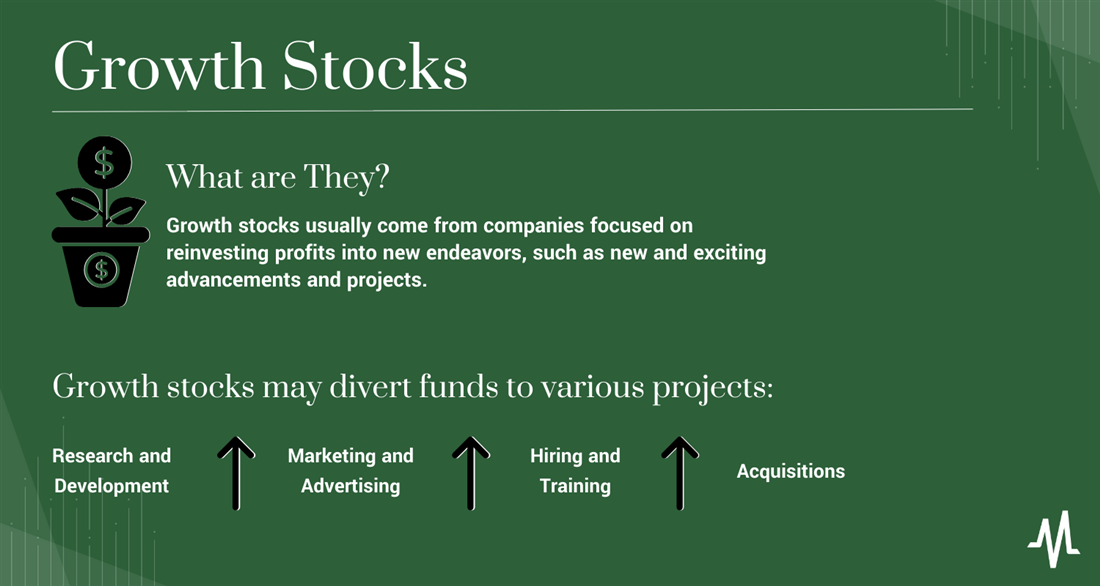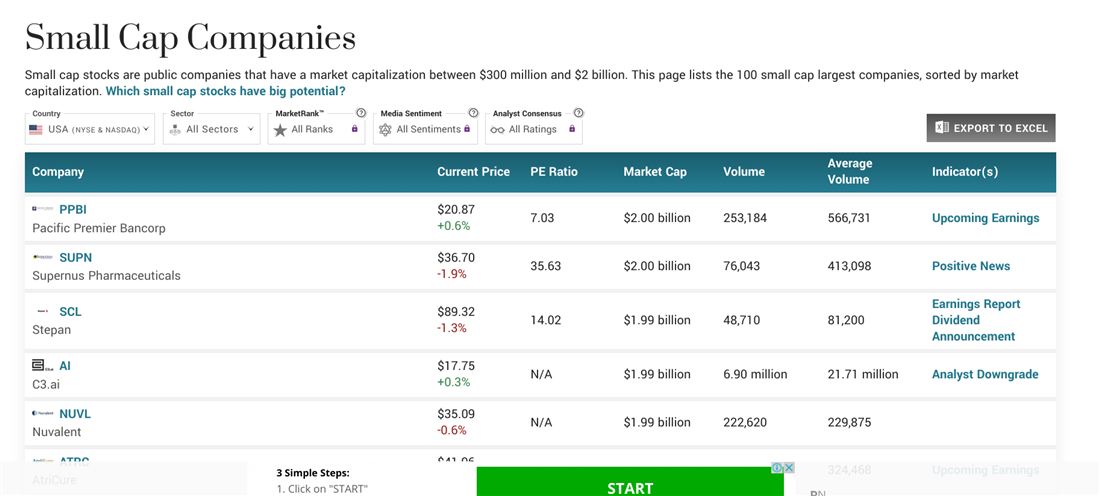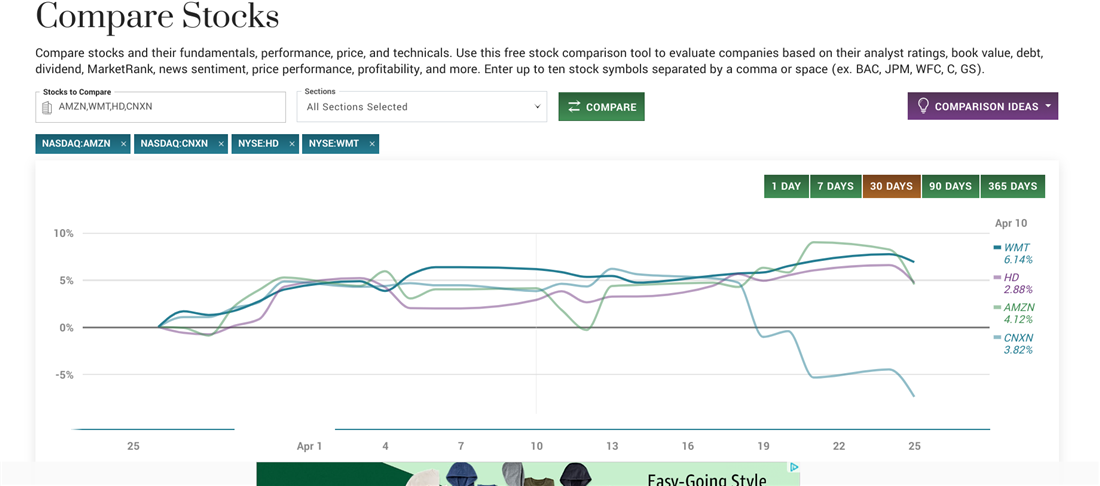If you're investing in growth stocks, your primary goal is to buy stocks of companies that have the potential to provide higher returns than the overall market.
Learn the basics of the growth stock definition (including what they are not) and the risks and rewards associated with investing in them. Growth stocks are worth considering if you want to diversify and capture higher returns than the overall market.
What is a Growth Stock?
Growth stocks are the daredevils of the investing world — packed with potential but also peril. These stocks usually have earnings or sales that zoom past the competition. Investors often pay top dollar for them, betting they'll hit it big.
After all, with great risk comes great reward and occasionally a crash. You can find growth stocks in all sizes, from small caps (companies with a market value between $250 million and $2 billion) to mega caps (companies with a market value of $200 billion or more).
Many of these small companies might be worth the bet, as well as some larger, more established mega caps, including Amazon.com Inc. NASDAQ: AMZN and Apple Inc. NASDAQ: AAPL, which now have revenue so large that some investors no longer consider them growth stocks. Apple even now pays dividends, which ignites the debate of dividends vs growth stocks.
A growth stock offers the potential to buy low and sell high. They can offer returns higher than the broader market and perform better than traditional dividend stocks over time. But they're also typically more volatile. To maximize your profits, you'll need patience.
It pays to employ dollar-cost averaging, meaning buying shares using fixed increments of money over a certain period. You can also use buy-and-hold strategies, in which you purchase stocks and hold onto them for an extended period, regardless of market fluctuations. You may also choose growth funds, which are mutual funds or exchange-traded funds (ETFs) that include many growth stocks.
Regardless of which strategy you use, one benefit of growth investing is that it can work for any investor, with conservative investors benefiting from investing smaller amounts and younger investors able to put more money into these stocks to generate wealth.

What Growth Stocks Are Not: A Deeper Dive into Growth Stocks
Sometimes you'll hear blue-chip stocks referred to as growth stocks. But don't be fooled. These are simply big companies that have already hit their peak. They probably won't experience massive growth without industry disruption or breakthrough technology.
To find the best growth opportunities, look to smaller-cap companies. These are the stocks where you can find real potential for incredible returns, though they come with more risk due to their size and lack of liquidity. You can find these by clicking on "small-cap stocks" on MarketBeat.

Growth stocks also aren't penny stocks; in other words, you won't see growth stocks trading for fractions of a cent or heavily promoted investments with no substance. Growth stocks generally don't pay dividends because any profits they make are invested back into the company rather than paid out as a reward to investors. This enables them to grow faster.
Don't confuse them with cyclical stocks, either — this type of stock follows the general trend of the economy and may not offer the same stability as an actual growth stock. The evergreen trend of a genuine growth stock is your best bet to reap huge rewards.
Growth Stocks vs. Value Stocks
What's the difference between growth and value stocks, and what is a good growth rate for a stock? While they have similarities, they're two distinct investment strategies. And while they can both produce positive returns, there are some key differences.
Growth stocks can give you above-average returns in a relatively short time frame. These companies usually have higher valuations than their counterparts and are expected to deliver more growth in the future. They're often found in industries such as technology and biotechnology and offer revolutionary or "disruptive" products and services. You can often find them on MarketBeat's media sentiment stocks list.
Before investing in a growth stock, consider what's driving its growth and how easily disruption can occur. On MarketBeat, you can compare a stock, for example, Amazon, to its competitors and potential competitors and examine shifts in the market by clicking on "comparison."

If you click on Amazon's stock page, you can view recent headlines, the data of its recent earnings reports (right), and see analyst ratings, which will help you gauge its growth potential.
On the other hand, value stocks offer investors the opportunity to buy them at a lower price than their intrinsic value might suggest. These stocks might be trading at a discount due to market sentiment or other factors. When looking at value stocks, ensure they have strong fundamentals, such as strong cash flow, low debt levels and consistent dividend payments over time.
You can earn long-term capital gains by buying and holding them until they reach their true market value.
Both growth and value investing can be solid strategies, depending on your goals and risk tolerances. However, understand the differences before diving into either one — you don't want to miss out on potentially lucrative opportunities due to not knowing what type of stock you're dealing with.
History of Growth Stock Investing
The 1930s were a decade of despair when the Great Depression wreaked havoc on capital markets, obliterating nearly 90% of value. While others were running towards the exits in a panic, Thomas Rowe Price Jr., founder of T. Rowe Price, saw an opportunity. He placed his bets on companies with little competition — those protected from the government's New Deal policies.
Much to his doubters' surprise, Price's first fund generated an incredible return of 400% over ten years. His investment ideas gained traction and inspired Phil Fisher to write "Common Stocks and Uncommon Profits," a gold standard for finding growth companies. It focused primarily on innovative and tech stocks.
Price's techniques are still used today, even when growth stocks have been perceived as overvalued, like high P/E growth stocks, such as in the 1970s and '80s or after the tech bubble burst in the early 2000s. He knew that there would always be those companies that would manage to soar to impressive new heights and reward their investors.
Example of a Growth Stock and How it Works
Amazon is one of the market's most exciting and recognizable growth stocks, with shares increasing tenfold since the company went public in 1997 at $18 per share. Those early investors would have seen a return of over 115,933 percent as of December 2022. That means a $10,000 investment would be worth $11.5 million as of that date. It gives new meaning to the question: "What is a good growth rate for a stock?"
Amazon was founded as an online bookstore, but since then, it has expanded to dozens of industries, including cloud computing, streaming media, artificial intelligence and more. It has always kept its focus on innovation and disruption. For example, it quickly became a leader in e-commerce by introducing one-click shopping, automated product recommendation engines and one- and two-day shipping.
It also focused heavily on customer service by offering free returns on items, simplifying returns policies and providing 24/7 customer support. This enabled it to capture market share from brick-and-mortar retailers and expand into other categories, such as apparel and home goods. Its foray into cloud computing has also helped it reach over $500 billion in annual revenue in 2022.
The stock price of Amazon reflects this rapid growth in the huge rewards investors have reaped if they bought from the start. Some investors don't consider Amazon a "pure" growth stock anymore, even though it still has the potential to grow. Suppose you weren't able to jump onboard on Amazon early. There's still an opportunity to benefit from owning its stock now that it's a more mature company with consistent earnings reports due to its success across multiple sectors. The stock price may not continue climbing at the same rate as before, but you can still enjoy gains if you hold onto your shares.
Pros and Cons of Growth Stocks
Growth stocks can offer incredible returns, but they come with risks. Here are some of the pros and cons.
Pros
Below, we outline the pros of investing in growth stocks:
- Potential for high returns: Growth stocks offer the potential for higher returns than more established companies. They are often smaller companies that have yet to reach their full potential. They may be trading at a much lower price per share than their large, well-established counterparts, but if all goes well, they could become very valuable.
- Exciting business models: Growth stocks usually represent innovative companies with creative business models that can disrupt existing markets or create new industries. Investing in stocks trending in the media can be exciting and rewarding as you watch them grow and develop into powerhouses in their field.
- Diversification: Growth stocks, such as those on the trending stocks list from MarketBeat, can diversify your portfolio by adding exposure to different types of businesses and industries that may not be represented elsewhere. Owning various growth stocks across multiple sectors can reduce risk and potentially increase returns over time.
Cons
Here are some of the major cons of investing in growth stocks:
- Volatility: One of the main drawbacks to investing in growth stocks is the potential for more volatility than with more established companies. Shares could shoot up in value but also plummet quickly if there are any unexpected changes or issues with the company's business model.
- Lack of liquidity: Because many growth stocks are smaller companies, there may not be enough buyers or sellers at any given time to easily buy or sell shares when needed. This makes it difficult to exit positions quickly or take advantage of market opportunities when they pop up.
- Unproven track record: Growth stocks are often young companies with little history or data on their performance and operations, making it hard to assess their potential.
Room to Grow
Investing in growth stocks can be risky, but there's an enormous potential for rewards and the chance to create wealth over time. Of course, you must stay aware of the risks, do your research and ensure you understand what you're getting into before taking the plunge into growth stocks.
FAQs
If you're still interested in the growth stocks definition after this article, you might have further questions before putting money into them, such as "What are growth stocks?" or "What is a growth stock mutual fund?" Below, we've tackled some of the most common.
What is considered a growth stock?
Growth stocks are companies expected to grow faster than the average company. They usually involve smaller, younger companies with a strong potential for growth but also can include well-established businesses undergoing rapid expansion or that have a competitive advantage. They offer higher levels of risk because they're less established than traditional stocks, but they can offer the potential for higher returns.
What is the difference between growth and value stocks?
Growth and value stocks have different characteristics that make them attractive to different investors. Growth stocks typically have a higher growth and return potential, while value stocks tend to be more stable with lower risks. Growth stocks often involve small companies or startups with new products or services that could create large returns for investors if they succeed, while value stocks are typically more established companies with more consistent earnings. Some have low price-to-earnings ratios, meaning they could be undervalued. But there are also low P/E growth stocks.
Why do people buy growth stocks?
People buy growth stocks because they offer the potential for large returns. They are often small, young companies with new products and services that could create big profits if they succeed. They also tend to be more volatile, meaning you can make money quickly. However, you can also lose money on a less established stock that offers less liquidity.
Before you consider Amazon.com, you'll want to hear this.
MarketBeat keeps track of Wall Street's top-rated and best performing research analysts and the stocks they recommend to their clients on a daily basis. MarketBeat has identified the five stocks that top analysts are quietly whispering to their clients to buy now before the broader market catches on... and Amazon.com wasn't on the list.
While Amazon.com currently has a "Moderate Buy" rating among analysts, top-rated analysts believe these five stocks are better buys.